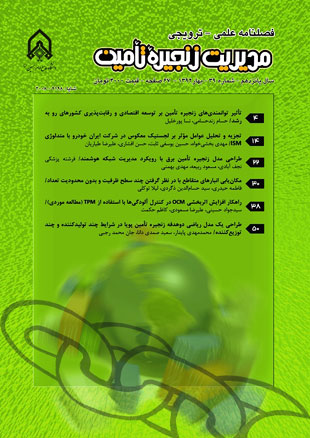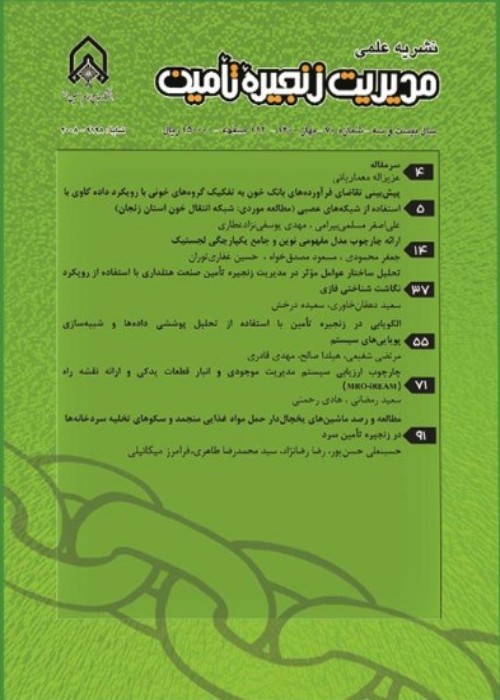فهرست مطالب

فصلنامه مدیریت زنجیره تامین
پیاپی 39 (بهار 1392)
- تاریخ انتشار: 1392/04/20
- تعداد عناوین: 6
-
-
صفحه 4فضای رقابت به دلیل نوآوری در تکنولوژی و نیازهای مشتریان که دائم در حال تغییر هستند پیچیده تر شده است. این تغییرات، سازمان ها و کشورها را به سمت رقابتی شدن مجبور میکند. در چنین شرایطی یا باید رقابت کرد و یا خطر حذف شدن را پذیرفت. از سوی دیگر، کشورها با توسعه توان رقابتی مسیر رشد اقتصادی را فراهم میسازند. در این مقاله پس از شناسایی و استخراج توانمندی های زنجیره تامین و رقابت پذیری، میزان تاثیر این مولفه ها بر پیشرفت و توسعه اقتصادی ایران بررسی می شود. قابلیت های زنجیره تامین در قالب چهار بعد و ابعاد رقابت پذیری در هشت بعد استخراج گردید. با توجه به محدودیت جامعه خبرگان بهمنظور استخراج میزان تاثیر ابعاد بر یکدیگر از تکنیک «دیماتل»3 استفاده شد. یافته ها و نتایج تحقیق نشان داد که ابعاد توانمندی های زنجیره تامین بر رقابت پذیری کشورهای رو به رشد تاثیرگذار بوده و معیار «یکپارچگی شبکه» بهعنوان تاثیرگذارترین عامل از عوامل توانمندی های زنجیره تامین و «قیمت» از مولفه های رقابت پذیری به عنوان تاثیرپذیرترین عامل شناسایی شدند.
کلیدواژگان: زنجیره تامین، پیشرفت اقتصادی، رقابتپذیری، تکنیک دیماتل -
صفحه 14مفهوم لجستیک معکوس در دهه های اخیر به سه دلیل مهم زیر مورد توجه قرار گرفته است:•انگیزه های رقابتی و بازاریابی•انگیزه های مستقیم اقتصادی•موارد زیست محیطیبا تنگ تر شدن حد و مرزهای قانونی، انتخاب های زیادی برای شرکت ها جز رفتن به سوی اجرای لجستیک معکوس باقی نمی ماند. اجرای لجستیک معکوس برای مدیران ارشد یک تلاش همراه با ریسک می باشد، زیرا شامل جنبه های مالی و عملی است و عملکرد شرکت را در دراز مدت مشخص می کند. امروزه لجستیک معکوس به یکی از پرچالش ترین موضوعات در حوزه تامین صنعت خودرو تبدیل شده است. از این رو تجزیه و تحلیل عوامل موثر که عملکرد لجستیک معکوس را به تعویق می اندازد، حائز اهمیت است. در این مقاله سعی شده است تا تجزیه و تحلیل عوامل موثر در لجستیک معکوس بیان شود. برای انجام این کار ابتدا ادبیات موضوع بررسی شده و سپس با خبرگان بخش لجستیک و لجستیک معکوس در صنعت خودرو مصاحبه های نیمه ساخت یافته ای صورت پذیرفته و در نهایت در اثر تطبیق نتایج حاصل از مرور ادبیات موضوع و مصاحبه با خبرگان، یازده مورد کلیدی از موانع شناسایی شدند. پس از آن با استفاده از رویکرد مدل سازی ساختاری تفسیری و نیز تجزیه و تحلیل نتایج حاصل، اولویت بندی مناسبی از موانع موجود ارائه گردیده است.
کلیدواژگان: لجستیک معکوس5، برگشتی ها6، موانع7، مدل سازی ساختاری تفسیری (ISM) -
صفحه 22وجود تلفات بسیار در زنجیره تامین برق کنونی ایران باعث هدررفت بخش مهمی از سرمایه های ملی و اثرات سوء زیست محیطی می گردد. توسعه به کارگیری انرژی های سبز به عنوان منابع جدید انرژی و تجدید ساختار شبکه های برق می تواند زمینه مناسبی را جهت کاهش عمده تلفات و بهینه سازی زنجیره تامین برق فراهم آورد. این مقاله بر شبکه هوشمند مابین خانه هایی که با سیستم برق خورشیدی متمرکز است و توانایی این سیستم را از حیث کاهش عمده تلفات با سیستم فعلی انتقال برق از منظر تحقیق در عملیات در قالب مدل های ریاضی مورد مقایسه قرار می دهد.
کلیدواژگان: زنجیره تامین برق، شبکه هوشمند، مدل ریاضی، انرژی سبز، کاهش تلفات -
صفحه 30در دهه های اخیر، مسئله انبارهای متقاطع منجر به پیدایش رویکرد نوینی برای طراحی انبارها و مراکز توزیع در مسائل حمل و نقل شده است. ایده اصلی انبار متقاطع انتقال مستقیم محموله های وارده به انبار توسط وسایل نقلیه خروجی بدون ذخیره کردن آن هاست. اولین تصمیم برای به کارگیری یک انبار متقاطع، تعیین مکان برای احداث انبار مورد نظر می باشد. به همین منظور در این مقاله به مسئله طراحی انبارهای متقاطع در شبکه زنجیره تامین چند محصولی، دو سطحی که در سطح اول تک منبعی و در سطح دوم چند منبعی است، پرداخته می شود. به منظور افزایش کارایی مسئله، برای هر کدام از انبارها و انبارهای متقاطع چند سطح ظرفیت در نظر گرفته شده است. در نهایت به منظور اعتبارسنجی مدل و تعیین عملکرد آن 8 مسئله متفاوت با استفاده از نرم افزار GAMS حل شده است.
کلیدواژگان: انبار متقاطع، مکان یابی، طراحی شبکه زنجیره تامین، چند سطح ظرفیت -
صفحه 38در این مقاله به بررسی سوابق نتایج آنالیز روغن موتور ماشین آلات کوماتسو در کارگاه سد مخزنی آغ چای و آلودگی های موجود در نمونه های روغن که توسط آنالیز روغن شناسائی گردید و هم چنین بررسی علل پیدایش و مخفی ماندن آلودگی ها پرداخته شده است.
در این راستا ابتدا علل پیدایش و مخفی ماندن آلودگی های خاک، سوخت و آب از دیدگاه فنی و CM4 مورد بررسی و شناسایی قرار گرفته، سپس این علل از دیدگاه TPM5 بررسی و مشخص شده است و در ادامه مولفه های افزایش اثربخشی نت موتور ماشین آلات کوماتسو از دیدگاه TPM و نقش و تاثیر OCM6 در تعیین هر یک از مولفه های فوق الذکر مشخص گردیده و در نهایت راهکارهای افزایش اثر بخشی OCM با رویکرد TPM در قالب یک مدل ارائه شده است.
کلیدواژگان: آنالیز روغن، نت بهره ور فراگیر، آلودگی ها، اثربخشی -
صفحه 50در بسیاری از بنگاه های اقتصادی تامین محصولات با کیفیت با کمترین هزینه از اهداف اصلی آنها به شمار می رود. تحقق این دو هدف هم زمان و با یکدیگر در بسیاری موارد امکان پذیر نیست. در این مقاله یک مدل ریاضی دو هدفه با رویکردی یکپارچه جهت تعیین جریان محصولات در طول زنجیره تامین پویا در سطوح تولید، توزیع و بازار ارائه شده است. هدف مدل پیشنهادی کمینه سازی هزینه-های خرید، حمل و نقل و نگهداری محصولات از یک طرف و بیشینه سازی خرید محصولات با کیفیت بالاتر از طرف دیگر می باشد. در نهایت، جهت ارزیابی مدل پیشنهادی، با به کارگیری روش محدودیت اپسیلن4 به عنوان یک نگرش بهینه سازی برای حل مسائل چند هدفه، یک مثال جامع برگرفته از مطالعه موردی یک سازمان نظامی حل شده است.
کلیدواژگان: زنجیره تامین پویا، تولید، توزیع، روش محدودیت اپسیلن
-
Page 4Innovation in technology and customer requirements are constantly changing and it causes competitive environment to be became more complex. These changes lead organizations and countries to become more competitive. In this situation must compete or accept denying. In other hand, countries create growth path by developing of competitive capacitance. In this paper aspect of supply chain capability and competitiveness are identified and extracted and the impact of these components on the economic development of Iran has been investigated. Supply chain capabilities were extracted in 4 dimensions and 8 dimensions for competitiveness. According to limitation of experts to extract dimensions effect on the other is used DEMATEL technique. Findings and results research based on dimensions of supply chain capabilities have an effect on competitiveness and economic development of developing countries. “Network Integration” is evaluated as the most influencing factor and being influenced factor is “price”.Keywords: Supply Chain, Economic Development, Competitiveness, DEMATEL Technique
-
Page 14The concept of reverse logistics has received growing attention in the last decades, due to a number of factors. Competition and marketing motives, direct economic motives and concerns with the environment are some of the important of them. With the legislative measures tightening up, there are not many options left with the companies, but to go for reverse logistics practices. The implementation of these may be a risky endeavor for the top management as it involves financial and operational aspects, which determine the performance of the company in the long run.Today the reverse logistics has become one of the most challenging subjects in automobile Industry’s supply chain. Hence the recognition of the barriers which hinder the reverse logistics application is so important. Since the researchers usually discuss on the every barrier separately.There is a need to develop a model which shows all the barriers and their ranking in a sol format. In this paper we tried to find the major barriers in reverse logistics hence we review the published literature in reverse logistics area and we interview with some experts in logistics sector at the specific formats. And at the end we adjust the first phase with the second one. Then we used the interpretive structural modeling to ranking the barriers and identifying the relation between them.Keywords: Reverse logistics, Returns, Barriers, Interpretive Structural Modeling (ISM)
-
Page 22There is lots of loss in current Iranian electric supply chain that causes wasting of national investment and bad effect on environment. Green energy development as a new source of energy and reconstruction of electric network can provide a suitable field for reduction of loss and improvement of electric supply chain. This article focuses on a smart grid between houses with solar power system and compare this system with current transmission system from operation research point of view, in the form of mathematical model.Keywords: Electric Supply Chain, Smart Grid, Mathematical Model, Green Energy, Loss Reduction
-
Page 30In recent decades, cross-docking problem has led to a new approach to design warehouses and distribution centers in transportation problems. The main idea of the cross-docking problem is transportation of incoming shipments directly by outbound trucks without saving them. Cross dock locating is the first decision for using them. Therefore, this paper addresses an evaluation of cross dock designing problem in two levels, first level is single-source and second is multi-source. To increase the problem efficiency, multiple capacity levels are considered for each cross dock and each warehouse. Finally, eight different instances are solved by using GAMS software to evaluate the model's performance and validate it.Keywords: Cross, Dock, Location, Supply Chain Network Design, Multiple Capacity Levels
-
Page 38This article studies the history of Komatsu machinery engine oil analyze results in Aghchy reservoir dam and impurities in the oil samples that was determined by oil analyze, also surveys causes of contamination genesis and hide.In this regard, primarily, the causes for genesis and hide of contaminations, including soil, water and fuel were identified and evaluated technically and by CM then TPM, Then the components for increasing the effectiveness of Komatsu machinery motor maintenance according to TPM and role and effects of OCM in determining each of mentioned components was specified. Eventually the solutions for increasing effectiveness of OCM with approach of TPM are presented based on a model.Keywords: Oil Analyze, Total Productivity Maintenance, Contaminations, Effectiveness
-
Page 50In many financial firms, providing high-quality products at the lowest cost is one of their main objectives. Obtaining these two objectives simultaneously with each other in many cases are not possible. In this paper, an integrated bi-objective mathematical model to determine flow of products throughout dynamic supply chain in levels of production, distribution and market is presented. The goal of proposed model is to minimize purchasing, transformation and holding costs of products and to maximize purchasing high quality products. Finally, to evaluate the proposed model using ε-constraint method as an optimization approach for multi-objective problems, an example for an army organization is solved.Keywords: Dynamic Supply Chain, Production, Distribution, ? Constraint Method


